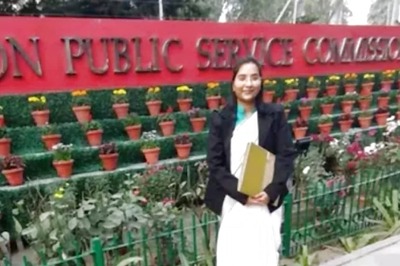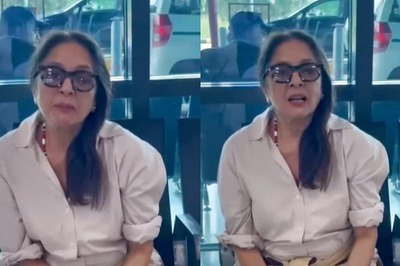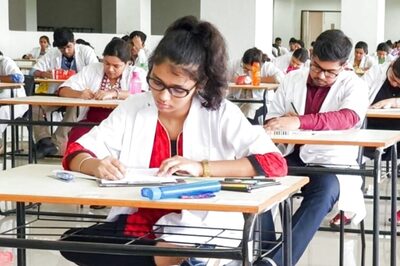
views
This year marks the bi-centenary of a famous letter written by Raja Ram Mohun Roy (1772-1833) to the then Governor General Lord Amherst advocating the cause of modern scientific education in India. While this letter, based on incomplete and faulty reading, has been drawn into an unfortunate controversy recently, its value has been vindicated by the fact that all governments in independent India from Nehru to Modi have prided upon building modern scientific institutions as Roy had desired.
On December 11, 1823, Roy wrote a letter to Lord Amherst, Governor General of India (1823-28), in the backdrop of the East India Company’s government establishing a Sanskrit College in Calcutta. Roy argued that instead of establishing this ‘new Sangscrit School’, the government should consider an institution to instruct the natives of India in “Mathematics, Natural Philosophy, Chemistry, Anatomy and other useful sciences, which the nations of Europe have carried to a degree of perfection that has raised them above other inhabitants of other parts of the world” (Sophia Dobson Collet, The Life and Letters of Raja Rammohun Roy, P.458).
Roy had prescience for science education. Roy’s letter antedated the establishment of the first medical college (Calcutta Medical College, 1835), the first Engineering College (Thomason College of Engineering, now IIT, Roorkee, 1847), first science college (Jubbulpur, 1860) in India. He had the best interest of India in his heart while advocating a curriculum of mathematics, natural philosophy (i.e. physics), chemistry and anatomy etc. In 1835, the Medical College was set up in Calcutta. Roy was no longer alive to rejoice in it. His friend Prince Dwarkanath Tagore, grandfather of the poet, took keen interest in the institution and announced munificent prizes for meritorious Indian students. It was here on January 10, 1836 that Madhusudan Gupta carried out the first human cadaver dissection, thereby breaking religious and social taboo prevalent in Indian society for centuries. Shakunt Pandey in an article in Science Reporter (November, 2017) informs that as recently as 2011 doctors of the Anatomy Department of Calcutta Medical College have unearthed some document that showed how the Hindu pandits were alarmed at the foundation of the medical college, and kept a vigil that corpses were not brought in the college for dissection (P.49).
On the other hand, there was Dwarkanath Tagore, Roy’s friend, who had announced an annual donation of Rs. 2,000 to the Medical College for being disbursed as prizes for Hindu students performing dissection. His biographer Krishna Kriplani informs that Dwarkanath was himself present in the dissection room to overcome the repugnance of Hindu sentiments to dissection (Dwarkanath Tagore- A Forgotten Pioneer: A Life, P.111).
Madhusudan Gupta, who hailed from Vaidya caste, traditional practitioners of Ayurveda in Bengal, carried out a coup against his own class. Gupta, who taught Ayurveda in Sanskrit College, was persuaded by the likes of David Hare and John Drinkwater Bethune to perform the dissection. Gupta knew that Sushruta Samhita, ancient Sanskrit text on medicine and surgery, mentions about a number surgical processes and instruments. Ancient Hindus perhaps could not have arrived at this knowledge without performing human cadaver dissection. However, as smriti-shastras triumphed over Sushruta, touching a human cadaver became an unclean act putting an end of a scientific odyssey. It was only in the nineteenth century, when this taboo was broken; and the stagnated stream of knowledge began to flow anew.
“A few short years”- says a 1839 brochure of the Bengal Medical College-“since it was considered a vain chimera to suppose Hindoos of good caste could ever be brought to pursue the study of the Anatomy in Dissecting-room, and by many they were considered incapable of mastering the difficulties of science, or of attaining proficiency in a profession so complicated as that of medicine. But the time has shewn that these assertions are unfounded”. (The Medical College of Bengal, P.ii).
Dwarkanath’s scholarship directly helped two graduates of Calcutta Medical College pursue higher studies in medicine in Britain. For two other students, scholarship came from other sources. In all, four students viz. Bholanath Bose, Suryakanta Chakraborty, Dwarkanath Bose and Gopalchandra Seal accompanied Dwarkanath during his second and final voyage to Britain in 1844. Two years later they obtained a diploma of College of Surgeons, whereas three of them were awarded M.D. Degree (A Forgotten Pioneer, P.111). Though this act, the Hindu society broke another taboo- undertaking sea voyages. The path had been prepared by Roy himself, who was the first Hindu gentry to go overseas. The religious prohibition on sea voyages, which had fallen upon the Hindu society, in the medieval ages due to historical circumstances, was finally passing away. In the subsequent decades, it became fairly common to go abroad for education and career like Indian Civil Services.
II
A few years ago US-based author and activist Rajiv Malhotra began a tirade against “de-Sanskritization” efforts of Raja Ram Mohun Roy based on the aforesaid letter. Malhotra’s tweet dated May 28, 2019 proves that he was not conversant with the contents of the letter. Malhotra presumed that it was written to British Prime Minister William Pitt instead of Governor General Lord Amherst. In 1823, Roy could not have written to William Pitt, the Senior (1707-78), or William Pitt, the Junior (1759-1806), since both these Prime Ministers of Britain were long dead and gone. Coincidentally, Lord Amherst’s Christian name was also William Pitt, but Roy addressed him with his full name leaving no scope for doubt on that count.
At the same time, Malhotra issued an 18 min 33 sec video interview on YouTube deprecating Roy as a supporter of colonialism based on the letter. It was evident that Malhotra (who took down the discourse to the level of Makke di Roti, Sarson da saag and Bhangra) had not paid sufficient attention to the academic and social trends in the nineteenth century.
Roy’s letter nowhere advocated terminating support to Sanskrit education per se. Roy’s argument that as there were already numerous teachers of Sanskrit in various parts of the country, the government will do well by providing them grants, rather than starting a new institution that broke no fresh ground.
An examination of nineteenth century trends will reveal definite groundswell for English education in India. The Hindus took advantage of English education throughout in the nineteenth and twentieth century that gave them significant edge over the Muslims in government services, medicine, law, engineering, teaching profession and politics.
Syed Ameer Ali in his essay ‘A Cry from Indian Muslims’ (August, 1882) used tables to prove how Hindus outnumbered the Muslims in matter of government employment in Bengal Presidency. The picture was equally dismal for the Muslims elsewhere in India. Ameer Ali concluded that the backwardness of the Muslims under the British rule was due to their failure to take advantage of the English education. Ali, however, attributed this failure more to the general poverty amongst Muslims, rather than any unwillingness on their part to the study the language of an alien race (Syed Razi Wasti, ed, Memoirs and Other Writings by Syed Ameer Ali, P.171).
Those who wish to create the Sanskrit-English dichotomy overlook a few basic facts. Firstly, it was not Sanskrit, but Persian, whose political and official clout the English replaced in the nineteenth century. From the establishment of Delhi Sultanate to beginning of British rule, it was Persian which held sway in official circles. Even Roy, like many other educated men of his epoch, was adept in Persian. Urdu was the handmaiden of Persian. When the British began to substitute Persian and Urdu with English and local languages like Hindi and Bengali in judiciary and revenue administration, alarm bells started ringing for the Muslim intelligentsia. The Hindus, however, were favourably placed to take advantage of this situation.
Secondly, it is a popular myth that the British ‘imposed’ English upon India by the agency of Lord Macaulay. The truth is that English was equally welcomed in Nepal and Ceylon (now Sri Lanka) where there was no Macaulay. Without English, Swami Vivekananda could not have delivered his memorable lectures amongst the Tamils of Ceylon.
The Education Commission (1909) in Baroda, a princely state, rejected the proposal for Vernacular University, on the grounds that higher education in vernacular language would have little practical value, when rest of the India had committed to higher education in English.
The Hindus in the nineteenth century were discreet enough in appreciating the distinct spaces occupied by Sanskrit and English. Sanskrit did not offer subjects that were assuming practical importance in the nineteenth century like science, political science, law, geography etc. Sanskrit pandits pursued Veda, Dharma Shastras, Darshana, literature and grammar, etc, in the nineteenth century, even as they do today. Sanskrit is perhaps the only language where grammar could be studied even up to PhD level. Although many Hindu nationalists are starry-eyed about the scientific heritage of Sanskrit, except for Ayurveda and Jyotish (astrology), Sanskrit offered no such curriculum. Thus, while ancient India might have produced rust-free iron pillar, magnificent temples or even as some claim the Vimana, but there was no curriculum in Sanskrit that could produce a metallurgist, civil engineer and aeronautical engineer.
The Sanskrit College (estd. 1824) exists still, having recently been upgraded to a university. According to its website, the courses offered by the university are mostly in language, literature and philosophy. Could India have come of age in the nineteenth century world with such a curriculum?
Roy was not pleading the cause of ‘English’ education, but modern scientific education. His inspiration evidently was Lord Francis Bacon (1561-1626), a lawyer, Member of Parliament, and Queen Elizabeth I’s counsel, who played a major role in advancing education in Britain. Bacon’s natural philosophy represented a struggle with traditions, whereby he felt that Aristotelian cosmology had become obsolete. Roy, like Bacon, felt that knowledge production in India had failed to keep abreast of time.
People who did not find English convenient, also accepted the value of modern education. In 1846, Hyderabad Medical School (HMS), now Osmania Medical College (OSC), was set up during reign of Nizam IV Mir Farqunda Ali Khan Nasir ud Daula. While the medium of instruction was Urdu, the college was not for studying Unani or Ayurveda, but Allopathic medicine. The textbooks were translated from English to Urdu. This arrangement was, however, not found feasible in the long run, as there was no original research on medicine in Urdu. The language was thus switched to English in the latter part of the century.
III
What was Roy’s temporal perspective? It might be remembered that Warren Hastings, the first Governor General of India (1772-1785), followed a policy of ‘Orientalism’, under which oriental languages like Sanskrit, Arabic and Persian were promoted, and research was undertaken into Indic knowledge through institutions like Asiatic Society of Bengal, and erstwhile Fort William College. Under this policy, the British government established Central Sanskrit College in Varanasi, Calcutta Madrasa, Sanskrit College at Calcutta and Hindoo College in Pune, etc. The policy aimed at bridging the intellectual and emotional gap between the British and Indians.
Whereas the British wanted to instruct Hindus in Sanskrit, the Hindus themselves wanted to expose their younger generation to English. They thus founded Hindu College (estd.1817) in Calcutta and Elphinstone College (estd.1834) in Bombay. The foundation of both these institutions antedated the arrival of Thomas Babington Macaulay in India in 1835, thus giving lie to the assumption that English education was ‘imposed’ upon India by the British at the behest of Macaulay. The truth is that Hindus themselves wanted to take advantage of English language, as all latest, practical and scientific knowledge was available in that language.
The struggle between Sanskrit and English in the nineteenth century was not as acute as one tends to believe. For instance, Radhakanta Deb, author of eight volume Sanskrit encyclopedia Shabda-Kalpadrum, was associated with the governing body Hindu College (estd.1817) for upwards 40 years since its inception. Hindu College (later Presidency College) was founded to provide modern education in English language to students from Hindu families. In the later part of the century, the people who set up New English School (1880) in Pune, and subsequently the Fergusson College (1885) were all well-versed in Sanskrit — Bal Gangadhar Tilak, Vishnushastri K. Chiplunkar, Vaman Shivaram Apte and Gopal Raghunath Nandargikar, etc.
A conservative Radhakanta Deb was a die-hard opponent of Roy on the Sati abolition question in the 1820s and 30s. Blessed with a long life, he also had the opportunity take cudgels against Ishwar Chandra Vidyasagar on the widow remarriage question in the 1850s. Tilak’s anti-colonial credentials require no fresh introduction. He was the first Indian mass leader to be imprisoned on charges of sedition, not once, but twice. Similarly, Tilak was a conservative when it came to Age of Consent Bill, 1891. His knowledge of Hindu philosophy is borne out in his authorship of Gita Rahasya (1915), written while in Mandalay jail.
These examples refute the proposition that Roy was a supporter of colonialism. Why should different standards apply to Roy, Deb and Tilak, all of whom were multi-linguists? They all worked in their own languages, but also promoted English. Moreover, India’s approach to colonialism varied with time. It is important to note what Bankim Chandra Chatterjee says in the last chapter of his novel Ananda Math (1882), written half a century after Roy’s death:
“The English are great in objective sciences and they are apt teachers. Therefore, the English shall be made our sovereign. Imbued with a knowledge of objective sciences by English education our people will be able to comprehend subjective truth. Then there would be no difficulties to the spread of True Faith;- it will then shrine forth of itself. Till that is so, till the Hindus are great again in knowledge, virtue and power, till then English rule will remain undisturbed. The people will be happy under them and follow their own religion without hindrance”. (The Abbey of Bliss, Tr. Nares Chandra Sen-Gupta, P.199)
Whether Malhotra would dub Bankim Chandra Chatterjee, seer of Vande Mataram, also as a colonialist on the lines of Roy is speculative. In reality, they were both pragmatists who knew that India had fallen behind times, and required to be brought in line with rest of the advanced world by taking advantage of modern education.
It will be fitting gesture if India’s medical colleges, IITs and science institutions display a photograph of Raja Ram Mohun Roy along with full copy of this letter to pay homage to the architect of modern India.
The writer is author of the book ‘The Microphone Men: How Orators Created a Modern India’ (2019) and an independent researcher based in New Delhi. The views expressed are personal.



















Comments
0 comment